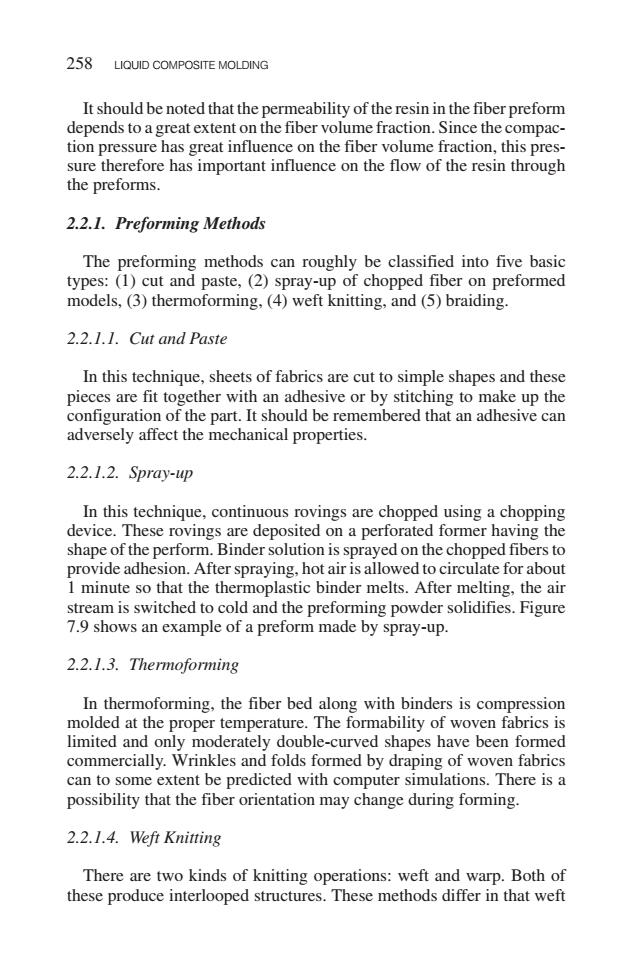正在加载图片...

258 LIQUID COMPOSITE MOLDING It should be noted that the permeability of the resin in the fiber preform depends to a great extent on the fiber volume fraction.Since the compac- tion pressure has great influence on the fiber volume fraction,this pres- sure therefore has important influence on the flow of the resin through the preforms. 2.2.1.Preforming Methods The preforming methods can roughly be classified into five basic types:(1)cut and paste,(2)spray-up of chopped fiber on preformed models,(3)thermoforming,(4)weft knitting,and(5)braiding. 2.2.1.1.Cut and Paste In this technique,sheets of fabrics are cut to simple shapes and these pieces are fit together with an adhesive or by stitching to make up the configuration of the part.It should be remembered that an adhesive can adversely affect the mechanical properties. 2.2.1.2.Spray--p In this technique,continuous rovings are chopped using a chopping device.These rovings are deposited on a perforated former having the shape of the perform.Binder solution is sprayed on the chopped fibers to provide adhesion.After spraying,hot air is allowed to circulate for about 1 minute so that the thermoplastic binder melts.After melting,the air stream is switched to cold and the preforming powder solidifies.Figure 7.9 shows an example of a preform made by spray-up. 2.2.1.3.Thermoforming In thermoforming,the fiber bed along with binders is compression molded at the proper temperature.The formability of woven fabrics is limited and only moderately double-curved shapes have been formed commercially.Wrinkles and folds formed by draping of woven fabrics can to some extent be predicted with computer simulations.There is a possibility that the fiber orientation may change during forming. 2.2.1.4.Weft Knitting There are two kinds of knitting operations:weft and warp.Both of these produce interlooped structures.These methods differ in that weftIt should be noted that the permeability of the resin in the fiber preform depends to a great extent on the fiber volume fraction. Since the compaction pressure has great influence on the fiber volume fraction, this pressure therefore has important influence on the flow of the resin through the preforms. 2.2.1. Preforming Methods The preforming methods can roughly be classified into five basic types: (1) cut and paste, (2) spray-up of chopped fiber on preformed models, (3) thermoforming, (4) weft knitting, and (5) braiding. 2.2.1.1. Cut and Paste In this technique, sheets of fabrics are cut to simple shapes and these pieces are fit together with an adhesive or by stitching to make up the configuration of the part. It should be remembered that an adhesive can adversely affect the mechanical properties. 2.2.1.2. Spray-up In this technique, continuous rovings are chopped using a chopping device. These rovings are deposited on a perforated former having the shape of the perform. Binder solution is sprayed on the chopped fibers to provide adhesion. After spraying, hot air is allowed to circulate for about 1 minute so that the thermoplastic binder melts. After melting, the air stream is switched to cold and the preforming powder solidifies. Figure 7.9 shows an example of a preform made by spray-up. 2.2.1.3. Thermoforming In thermoforming, the fiber bed along with binders is compression molded at the proper temperature. The formability of woven fabrics is limited and only moderately double-curved shapes have been formed commercially. Wrinkles and folds formed by draping of woven fabrics can to some extent be predicted with computer simulations. There is a possibility that the fiber orientation may change during forming. 2.2.1.4. Weft Knitting There are two kinds of knitting operations: weft and warp. Both of these produce interlooped structures. These methods differ in that weft 258 LIQUID COMPOSITE MOLDING